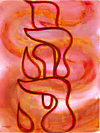|
Yahweh (יהוה)
Hebrew. “He who is”.
A word consisting of the four Hebrew letters, Yodh (י)
He (ה)
Waw (ו)
He (ה),
i.e. YHWH, the four-letter personal name of God. Since Hebrew has no written
vowels it can be vocalized in several different ways.
In order to counter confusion,
several vocalizations were proposed throughout history, often by adding
vowel points to the Hebrew consonants. This however, led to even more
possibilities and further confusion.
After Israel's exile into the Babylonian
Captivity, Hebrew had over time become a death language and from the
sixth century BC onward most of the Near East spoke Aramaic, a branch of
the Semitic family of languages, used as the lingua franca. When in the
early Middle Ages, between the 7th and 11th centuries AD, a group of
Hebrew scholars and scribes known as the Masoretes, wanted to
resuscitate the spoken form of the Hebrew language, they added
vowels to the written consonants, in an attempt to fix the pronunciation
and to allow the ancient texts to be read correctly. However, for the
name of God, they faced a problem.
Since the Jews deem the name of God
too sacred to be uttered,
they refer to it as Ha Shem (השם), i.e. “the Name”, and read YHWH as
Adonai
(אֲדֹנָי), a word meaning
“My
Lord”. Even today in English, many Jews spell the word God not in full,
but as G-d. As a result, no
one knew the exact pronunciation for the name YHWH and the Masoretes
hence took vowel points similar -though not identical- to those of the
word Adonai and added them to the name YHWH, which gave it the
pronunciation Yehowah (יְהֹוָה). Yet, most scholars agree that this is
not the way the name was originally pronounced. In line with other
references to God and His name, such as El (אל), Elah (אֵלָה) and Ehyeh
Asher Ehyeh (אהיה אשר אהיה), it is now generally accepted that YHWH is
be pronounced as Yahweh. The Hebrew name for
Jesus, i.e. Yeshua (ישוע) or
Yehosha (יהושע), means
“Yahweh
rescues”. The name is a compound of Yeho (יהו)
and shua (שוע)
or sha (שע), the first element
standing for Yahweh and the latter coming from the root yesha (ישע),
which means “rescue” and “salvation”. The word shua (שוע)
itself also means “lord” and “to cry out [for help]”. Furthermore, the
inscription that was written on the order of
Pilate in three
languages, i.e. in Hebrew, in Latin, and in
Greek, and put on the cross of Jesus during
the crucifixion, bore the Latin text: Iesus Nazarenus, Rex Iudaeorum (Iesvs Nazarenvs, Rex Iudæorvm),
which in English translates as “Jesus the
Nazarene, King of the Jews” and often seen in
Christian art represented by the acronym INRI. In Greek, the
inscription would have read: Iesus ho Nazoraeos ho basileus ton Iudaeon (Ἰησοῦς
ὁ Ναζωραῖος ὁ βασιλεὺς τῶν Ἰουδαίων),
whilst in one of the principal Hebrew translations of the New Testatment
the inscription reads: Yeshua Hanatzari, Melekh Hayehudim (ישוע הנצרי,
מלך היהודים), i.e.
“Jesus the Nazarean, King of the Jews”,
it should however be
noted that neither the Latin, Koine Greek nor Hebrew-Aramaic of the time
knew the use of punctuation marks, such as commas and points. Therefore,
at least theoretically, the Hebrew line might have included a
conjunction word, phrasing the text as: Yeshua Hanatzari Wemelekh
Hayehudim (ישוע
הנצרי ומלך היהודים),
i.e. “Jesus the Nazarene and King of the Jews”. If so,
the Latin acronym INRI would then in Hebrew
become YHWH (יהוה),
i.e. the name of God. This could perhaps explain why
the chief priests of the Jews
so anxiously wanted the inscription removed or changed, as described in John 19:21,
though most theologians and linguists agree that there is in fact no
proof of the claim of the added conjunction
in any of the Hebrew and Aramaic versions of these passages and
that the protesters just took issue directly with
the recognition of the alleged kingship of Jesus in the text, rather
than recognizing a supposed acronym forming the tetragrammaton YHWH.


Yishai (יֵשַׁי)
Hebrew name for the father of King David,
traditionally rendered as
Jesse in English. The name Yishai
is generally understood to mean “gift” or “God exists/God’s gift”,
derived from the Hebrew root יש (Y-Sh), meaning “to exist” or “to be”.
This etymology emphasizes his role in the divine plan, highlighting the
significance of his lineage in Israel’s monarchy and messianic
tradition. See also
Nazareth.

Yom
Kippur (יוֹם כִּפּוּר)
Hebrew. “Day of
Atonement”. A Jewish holiday of complete
fasting and penitence, on which no food or water is taken for the entire
day. It is said that one’s name is written in the Book of Life on this
day. It is the climax of the ten day period of repentance (Ten Days of
Awe), that begins with Rosh Hashannah and ends with the Day of Judgment,
the day on which Moses came down from Sinai bearing the second set of
tablets, after God had forgiven Israel for worshipping the Golden Calf.
It is the holiest day of the Jewish year, and provides prophetic insight
regarding the Second Coming of Messiah, the restoration of national
Israel, and the final judgment of the world.
 |